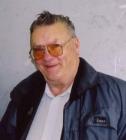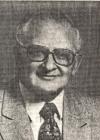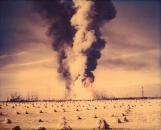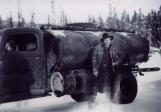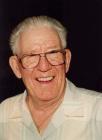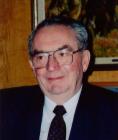15
Dan Claypool,Devon, Alberta
Born in Beechy, Saskatchewan and worked as a farmer, haying and thrashing on ranches in Southern Alberta- The Bar S and Anchor P. In 1949, I heard about the Leduc No. 1 discovery, and headed north to seek my fortune. Started roughnecking in the dumb corner on a conventional drilling rig. Worked on various types of drilling rigs for 5 years. Spent the next 48 years involved in drilling, production, safety, environment, and as a historian.
In October 1954, Texaco Pigeon Lake, well 16-26 went out of control and caught fire and legendary wild well firefighter Myron Kinley was called in from Texas to handle the job.
Along with Kinley came some people from Houston who would themselves in later years achieve the status of "legend"- then trainees Red Adair, Boot Hanson and Coutes Mathews. In addition, a six-man Texaco crew was tapped to do the capping; comprised of Earle Brown, Jim Daley, Buddy Johnson, Don Pearson, John Spargo, and myself.
Finally, among the many tools that Kinley used to cap that well was our Athey Wagon. In fact, it was originally designed and built expressly for that purpose.
Fighting high temperatures, the crew used the Athey Wagon and Boom to remove all the metal from around the well. Then, the capping crew- plus Kinley, Adair, Hanson and Coutes- placed an insulated 35 gallon drum on the wagon's boom end. This container was filled with some 450 pound of gelatin explosive sticks; caps and wires, leading to a detonator situated some 300 feet from the well behind a pile of dirt. A D-8 Cat skinner, directed by Kinley, moved the Athey Wagon and Boom into place, putting the barrel full of explosives at the base of the fire, which was now roaring about 15 feet over the standing BOP on the casing bowl.
Camped out behind the pile of dirt, the fire fighters and us in the capping crew lowered our heads in anticipation of a wind wave from the explosion. Kinley pushed down the handle on the detonator. The explosion- robbing the fire of oxygen- put the blaze out immediately as oil and gas rained down on us as the shock wave passed by.
Our capping crew then rushed in, unbolted the BOP, and allowed it to be lifted by the force of the oil and gas blow- escaping out of the 7 inch casing from the Devonian Reef, some 7,000 feet below- and laid it with beside the well. A crane brought in a 7,000 pound full opening ball type master valve, and with great difficulty guided it over the blow, so the blow was going up through the open valve. Quickly, yet carefully, trucks pumped water into the side ports and brought the well under control. In all, Texaco 16-26 had burned for two weeks before being extinguished.
16
A Working Piece of HistoryDecember, 2002
Canadian Petroleum Interpretive Centre, Devon, Alberta, Canada

17
The Athey Wagon built by Myron Kinley and used by his crew, including Dan Claypool. The Athey Wagon and Boom went into action one more time, when in 2000, they were pulled out of retirment at the Canadian Petroleum Interpretive Centre and put to work on a wild well in Little Bow, near Enchant, Alberta. The Athey Wagon and Boom performed perfectly and came back to rest, until it is needed again....19
Bill CummerCalgary, Alberta
Prior to my joining G.P. (General Petroleums) in 1943, I served two years in the RCASC of the Canadian Army being discharged for medical reasons with permanent rank of sergeant.
As to vital statistics, I was born in Drumheller, Alberta July 6, 1922, moved with family to Calgary in 1929 and attended Connaught, Sumalta and Central High Schools.
(The following is taken from Westburne Magazine, Fall 1984)
Bill's 40-year career covered the most exciting periods of the growth in the Canadian petroleum industry. He joined GP...in 1943 as a junior clerk and rose to positions in Westburne's senior management prior to his retirement.
GP, founded in 1941, operated two rigs in Alberta until the discovery of a major oilfield at Leduc in 1947. Bill established the company's Leduc office and the company expanded quickly as the demand for drilling services grew.
On March 8th, 1948, one of the most famous and widely publicized events in the history of the Canadian Petroleum Industry occured when the Atlantic No. 3 well blew out of control.
"The well remained out of control for six month and was declared a public menace," Bill recalled. "Two GP rigs were moved in to drill the relief wells that finally killed the blowout and we co-ordinated the operation for Imperial Oil and the Alberta Conservation Board."
...GP later drilled what became the discovery well in the Joseph lake field, the first commercial oilfield in the prolific Viking Sand....
In 1960...Bill assisted in establishing Westburne's first foreign contract drilling operation....
During his period of service as treasurer of the parent company, he helped expand Westburne's petroleum industry operations.
In July, 1976 Bill transfered to Hamilton, Bermuda as president of Westburne International Drilling Limited and served in this capacity until his retirement in 1984, he was also president of the parent company.
21
Shortly after the rig collapsed the well burst into flames creating tremendous interest in the international media, and bringing the prospects of the Alberta oil industry to the attention of the world.23
Doug DunnDevon, Alberta
as told by his wife, Gerry Dunn
1943- Doug Dunn went to work for his Dad who had trucks on the Alaska Highway when they were building it from Mile 0 in Dawson Creek. Drove for his Dad then some of his friends came up from Regina. Mickey Shantz drove for his Dad too. One trip Mickey was going down a hill took it out of gear and couldn't get it back in gear Doug was behind him and seen him go over the hill and Mickey was killed. Doug took his body back to Regina.
The Mayor of Dawson Creek had a daughter and he always said that if he caught anyone with her he would shoot him. So one night all the fellows were on a toot. Doug was really loaded and all of the fellows hauled him up on the porch and put him in Betty Spinny's bed and left him there.
1945- Doug joined the Canadian Army.
1947 March- Started for Gene Young Drilling as a roughneck. Atlantic #3 blew out in March 1948 in the Leduc field.
1948- Doug was working for Can-Tex as a Derrick hand when Atlantic #3 caught fire.
He was sharing a house with three other men in Calmar, Alberta just west of the well site.
The day the well blew it shook the dishes right off the table.
1948-1949- Worked for Gene Young Drilling, Can-Tex Drilling, and Canada West Drilling, as a Derrick hand.
1949-1950- Loadstar Drilling as Derrick hand and Drilling. At Peace River, Wabasca and Heisler.
1951-Shell Oil Drilling at Cochrane as swing driller at the Jumping Pound field.
Dominican Drilling. Owner had three rigs. The picture is here, but we do not know the names. Starting on the left you have the Motor Man, Derrick Hand, Roughneck, Doug Dunn, Roughneck.
1951-1952-Cascade Drilling Owner Fish Allen as toolpusher at Camrose and Leduc.
1952-1954-Regent Drilling for Lou McCouagh as Toolpusher in North Dakota. Doug was working one day and a young black fellow came to him to see if he could go to work for him. His family had their car and all their belongings stolen. So Doug said sure and put him to work as a roughneck. The rest of the crew said if he was working they were quitting. So in front of the men Doug phoned Lou and asked him to send another crew down right away, cuz this crew was quitting. The crew quickly said they would stay.
1953- Doug got Polio and spent 8 ˝ months in hospital and walked out on his own.
1954-1955- Went to work at the Garrison Dam as a stiff leg operator. The operator before him had dropped a pipe and made a man deaf.
1955-1956- Will I Lewis Drilling as a driller in Montana and Wyoming. In this time
he learned how to operate a Cable Tool rig. Robert and Lee Drilling had one.
1956- Returned to Canada in April with me, his wife and family.
1956- Northern Oilfield Ditcher's General Manager over Trucking and Construction.
1957- Owner and Operator of Loboy and Hiboy Transport Heavy Equipment and Oilfield Hauling.
1958- Boyles Bros. Diamond Dilling co. as Toolpusher at Saturna Island, BC, Gulf
Islands.
1959-1960- Riley Drilling Co. as Driller.
1961-1962- Just out of hospital, sold cars.
1964-1965- Owner of Klondike Motors.
1966-1968- Tri Line Systems and Upland Carriers Sales and Operations Manager.
1969-1972- Owner of Motel in Rycroft. Leprechaun Motor Lodge.
1972-1973- Intermountain Transport. Terminal Manager.
1973-1975- Tri Line Systems. Lease operator.
1975- Overseas, L.N.C. Libian National Oil Co. in Libya as Toolpusher and Drilling
Foreman.
1977-1979- Richter Drilling Australia, Toolpusher. Received an award from the
Australian Government for having the cleanest rig, lease and camps in Australia.
1979-1998- Owner of Tandanna Holdings Ltd. Working as a consultant for different
oil companies in western provinces. Doing construction, Drilling, Completions and
Production.
He started from the bottom and worked his way to the top. He treated anyone who
worked for him with a lot of respect never did swear at anyone he was dealing with.
25
Frank DusseaultEdmonton, Alberta
Born November 24, 1923 in Vimy, Alberta but grew up in Falher in Peace River county. Had very little formal education and worked on farms, etc.
Went to Yellowknife and worked in mines and drove truck. Worked on Diamond Drills with driller Charlie Cairnes. Joined RCAF and on discharge went to work for Cantex Drilling from March 1949- June 1949 again with driller Charlie Cairnes.
On July 15, 1959 I married Grace Anne Harper, a graduate nurse. After fifty three years, three daughters and many moves we are still together- wonderful!
September 1949 to Augsut 1959, I worked for Falcon Seaboard of Canada. The named changed to Canbridge Drilling at some time. I was in every position with them from roughneck to toolpusher. The company was owned by Frank Bridges and Ray Tull.
In 1959-1961 I went overseas for L.T.S.- Les Traveax Souterains. While there I lived in Algiers, worked in Sahara as a rig manager on a two year contract.
In 1961-1962 I was a pusher for Jennings Drilling and my superintendnet was Tony VandenBrink.
1962 -1963 I was on a 1 year contract in Libya to look after four rigs in the eastern half of the country. My single status family stayed in St. Albert, it was a tough year, but I completed the contract.
1964-1973 I was field superintendent and safety man for Jennings Drilling.
1973-1974 I was Drilling foreman for Iranian Oil Exploration and Production Co. Lived in Tehran, worked in and around the Persian Gulf and stayed until I completed the contract.
1974-1986 Cactus Drilling merged with Jennings International and I was safety man.
I retired at age 62 and am now close to 79 years of age. My health is fair to good, with my new pacemaker installed in March of 2002 and working fine.
People I worked with and respected for their hard work and honesty were:
Ray Tull, superintendent and part owner of Canbridge Drilling.
Tony VandenBrink, drilling superintendent of Jennings International Drilling.
George Novlesky, mechanic Cactus Drilling.
Glen Lagore, hired on right after grade twelve in Haghenden. He roughnecked for Canbridge, then went into directional drilling.
Bill Palensky, long time drilling superinendent for Jennings and Cactus.
Kendall Jennings, owner of Jennings Drilling, very honest and fair. He started retirement plan for pushers in 1973.
Ted Mulligan, came as a green roughneck to Canbridge Drilling and worked his way up to rig manager. He left to go drilling for Canadian Superior where he worked until retirement. Hell of a hand, never smoked or drank.
Ken Franko worked as driller and rig manager for Jennings and Cactus and stayed on with Precision when they bought out Cactus. He is now field superintendent for a large area. A very good person and rig man.
In my fairly long career around rigs, I've met many good people and a few not so good.
27
Garnet EdwardsCalgary, Alberta
Garnet Edwards was born in Belmont Manitoba in 1916. His family moved to
Lethbridge Alberta in 1928 and then Okotoks in 1929. In 1931 the Edward’s family
moved to Turner Valley, where Garnet finished his education and started driving truck in
the oilfields.
In 1939 Garnet moved east of Longview Alberta and continued driving truck. Later he
worked in a warehouse and tool dresser until he lost some fingers. In late 1934, Garnet
remembers working 12-hour days for $75.00 a month. Back in Turner Valley, he worked
for Union Drilling pumping water, driving truck and as a spare roughneck. Garnet also
did some welding for Sam Hector and working for Harry Hanson abandoning old oil
wells during the slack times.
In 1937 Garnet was working steadily as a roughneck and witnessed the growth, life, and
death of Little New York and Little Chicago. By 1941, Garnet had worked throughout the
field and at the age of 25 years he was recognized as the second youngest driller in
Canada.
In 1946 he joined Oilwell Reflow as a Cable Tool driller on Westflank #2. His crew
prepared and shot the well with 5,300 quarts of nitroglycerin and 2 tons of marbles- with
no luck and so he turned to wildcatting in Wainwright and Hanna. Leduc Consolidated
saw him move two Union Drilling steam rigs to Leduc in April of 1947. As the tool
push, he had to build camps for the crews. There were no telephones in the field and the
nearest supplies came from Calgary. The crews drilled two dry holes and Garnet had his
first “blowout” ˝ mile (.8 km) east of Atlantic 3. There were not any B.O.P’s being used
at that time and it took Garnet’s crew five days to kill the well.
After that, Garnet went Drilling again for Northern Development and then back to pushing for Union in the spring of 1948.
In 1949 he drilled and pushed for Commonwealth and went to Canada West Drilling as a field superintendent with six rigs and trucks. There was one overshot which was used on all and any fishing jobs and never was there a fishing job lasting longer than 3 days.
The job required much traveling and very little sleep, as there were only 2 people in the
Calgary office and the rest Garnet had to handle out of Leduc- including completions and
casing jobs. Canada West had the last steam drilling rig in Canada, and it finished up on
Hargal #3.
In 1951 Trinidad Leaseholds bought Canada West and Garnet stayed on with them until
they closed down in 1953. By that time he had drilled over 25 wells in the Leduc and
Calmar area.
It was off to Eastman Oilwell Survey to work as the area manager in Canada and then Garnet left in 1954 to go to Trinidad for 7 months to prepare to handle their contract operations in Canada. Back in Canada, Garnet worked for Leidecker Tool on wellhead and service work through Dayton Valley, Swan Hills and area.
In 1963 along with a partner, Garnet bought Tubetest and built it into a thriving company.
Garnet retired in 1978 and did some consulting and cared for his wife full time.
During his time in Edmonton, Garnet served on the executive of the O.T.S. and Oilmens
Bonspeil for many years. He was also a valued member of the Petroleum Club for 41
years and a member of the South Edmonton Optimists Club. He was inducted into the
Canadian Petroleum Hall of Fame in 1997. Since retiring Garnet has built 7 working
Cable Tool rig models, 18 spinning wheels and many other articles. Garnet Edwards is a
truly dedicated and valuable oil patch pioneer.
